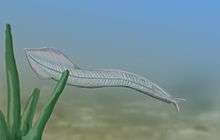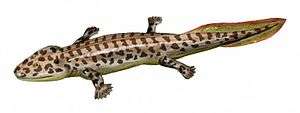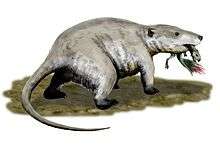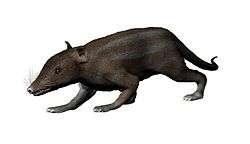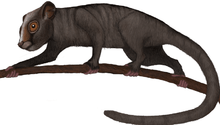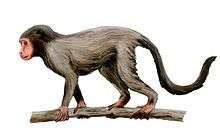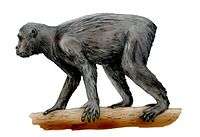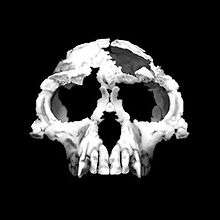Timeline of human evolution
The timeline of human evolution outlines the major events in the evolutionary lineage of the modern human species, Homo sapiens, throughout the history of life, beginning some 4 billion years ago down to recent evolution within H. sapiens during and since the Last Glacial Period.
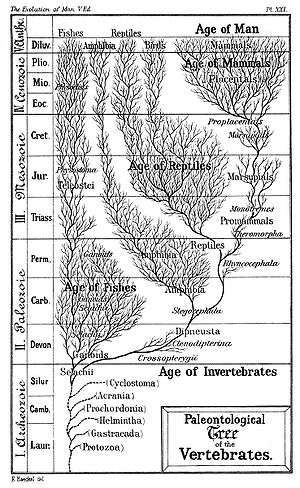
It includes brief explanations of the various taxonomic ranks in the human lineage. The timeline reflects the mainstream views in modern taxonomy, based on the principle of phylogenetic nomenclature; in cases of open questions with no clear consensus, the main competing possibilities are briefly outlined.
Overview of taxonomic ranks
A tabular overview of the taxonomic ranking of Homo sapiens (with age estimates for each rank) is shown below.
| Rank | Name | Common name | Millions of years ago (commencement) | |
|---|---|---|---|---|
| Life | 4,100 | |||
| Archaea | ||||
| Domain | Eukaryota | Eukaryotes (slime molds and related) | 2,100 | |
| Podiata | ||||
| Unikonts | ||||
| Obazoa | ||||
| Opisthokonts | Holozoa + Fungi s.l. | 1,300 | ||
| Holozoa | 1,100 | |||
| Filozoa | Choanozoa + Filasterea | |||
| Choanozoa | Choanoflagelates + Animals | 900 | ||
| Kingdom | Animalia | Animals | 610 | |
| Subkingdom | Eumetazoa | |||
| Parahoxozoa | ||||
| Bilateria | Triploblasts / Worms | 560 | ||
| Nephrozoa | ||||
| Deuterstomes | ||||
| Phylum | Chordata | Chordates (Vertebrates and closely related invertebrates) | 530 | |
| Olfactores | ||||
| Subphylum | Vertebrata | Fish / Vertebrates | 505 | |
| Infraphylum | Gnathostomata | Jawed fish | 460 | |
| Teleostomi | Bony fish | 420 | ||
| Sarcopterygii | Lobe finned fish | |||
| Superclass | Tetrapoda | Tetrapods (animals with four limbs) | 395 | |
| Amniota | Amniotes (fully terrestrial tetrapods whose eggs are "equipped with an amnios") | 340 | ||
| Synapsida | Proto-Mammals | 308 | ||
| Therapsid | Limbs beneath the body and other mammalian traits | 280 | ||
| Class | Mammalia | Mammals | 220 | |
| Subclass | Theria | Mammals that give birth to live young (i.e., non-egg-laying) | 160 | |
| Infraclass | Eutheria | Placental mammals (i.e., non-marsupials) | 125 | |
| Magnorder | Boreoeutheria | Supraprimates, (most) hoofed mammals, (most) carnivorous mammals, whales, and bats | 124–101 | |
| Superorder | Euarchontoglires | Supraprimates: primates, colugos, tree shrews, rodents, and rabbits | 100 | |
| Grandorder | Euarchonta | Primates, colugos, and tree shrews | 99–80 | |
| Mirorder | Primatomorpha | Primates and colugos | 79.6 | |
| Order | Primates | Primates / Plesiadapiformes | 75 | |
| Suborder | Haplorrhini | "Dry-nosed" (literally, "simple-nosed") primates: tarsiers and monkeys (incl. apes) | 63 | |
| Infraorder | Simiiformes | monkeys (incl. apes) | 40 | |
| Parvorder | Catarrhini | "Downward-nosed" primates: apes and old-world monkeys | 30 | |
| Superfamily | Hominoidea | Apes: great apes and lesser apes (gibbons) | 28 | |
| Family | Hominidae | Great apes: humans, chimpanzees, gorillas, and orangutans—the hominids | 20–15 | |
| Subfamily | Homininae | Humans, chimpanzees, and gorillas (the African apes)[1] | 14–12 | |
| Tribe | Hominini | Includes both Homo, Pan (chimpanzees), but not Gorilla. | 10–8 | |
| Subtribe | Hominina | Genus Homo and close human relatives and ancestors after splitting from Pan—the hominins | 8–4[2] | |
| (Genus) | Ardipithecus s.l. | 6-4 | ||
| (Genus) | Australopithecus | 3 | ||
| Genus | Homo (H. Habilis) | Humans | 2.5 | |
| (Species) | H. Erectus s.l. | |||
| (Species) | H. heidelbergensis s.l. | |||
| Species | Homo sapiens | Anatomically modern humans | 0.8–0.3[3] | |
Timeline
Unicellular life
| Date | Event |
|---|---|
| 4.1 Ga (billion years ago) |
The earliest life appears. |
| 3.9 Ga | Cells resembling prokaryotes appear. |
| 3.5 Ga | This marks the first appearance of oxygenic photosynthesis and therefore the first occurrence of large quantities of atmospheric oxygen on Earth. |
| 2.5 Ga | First organisms to use oxygen. By 2400 Ma, in what is referred to as the Great Oxygenation Event, the pre-oxygen anaerobic forms of life were wiped out by the oxygen producers. |
| 2.1 Ga | More complex cells appear: the eukaryotes. |
| 1.2 Ga | Sexual reproduction evolves, leading to faster evolution[4] where genes are mixed in every generation enabling greater variation for subsequent selection. |
| 0.9 Ga |
The choanoflagellates may look similar to the ancestors of the entire animal kingdom, and in particular they may be the direct ancestors of sponges.[5][6] Proterospongia (members of the Choanoflagellata) are the best living examples of what the ancestor of all animals may have looked like. They live in colonies, and show a primitive level of cellular specialization for different tasks. |
Animals or Animalia
| Date | Event |
|---|---|
| 700–660 Ma | 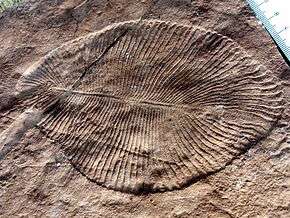 Dickinsonia costata from the Ediacaran biota, 635–542 Ma, a possible early member of Animalia. Urmetazoan: The first fossils that might represent animals appear in the 665-million-year-old rocks of the Trezona Formation of South Australia. These fossils are interpreted as being early sponges.[7] Separation from the Porifera (sponges) lineage. Eumetazoa/Diploblast: separation from the Ctenophora ("comb jellies") lineage. Planulozoa/ParaHoxozoa: separation from the Placozoa and Cnidaria lineages. Almost all cnidarians possess nerves and muscles. Because they are the simplest animals to possess them, their direct ancestors were very probably the first animals to use nerves and muscles together. Cnidarians are also the first animals with an actual body of definite form and shape. They have radial symmetry. The first eyes evolved at this time. |
| 570–550 Ma | 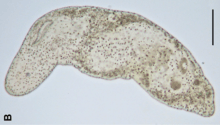 Proporus sp., a xenacoelomorph. Urbilaterian: Bilateria/Triploblasts, Nephrozoa (555 Ma), last common ancestor of protostomes (including the arthropod [insect, crustacean] and platyzoan [flatworms] lineages) and the deuterostomes (including the vertebrate [human] lineage). Earliest development of the brain, and of bilateral symmetry. Archaic representatives of this stage are flatworms, the simplest animals with organs that form from three germ layers. |
| 541 Ma | 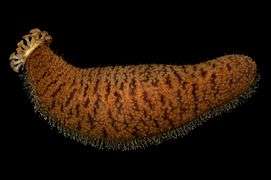 Most known animal phyla appeared in the fossil record as marine species during the Cambrian explosion. Deuterostomes, last common ancestor of the chordate [human] lineage, the Echinodermata (starfish, sea urchins, sea cucumbers, etc.) and Hemichordata (acorn worms and graptolites). An archaic survivor from this stage is the acorn worm, sporting a circulatory system with a heart that also functions as a kidney. Acorn worms have a gill-like structure used for breathing, a structure similar to that of primitive fish. Acorn worms have a plexus concentrated into both dorsal and ventral nerve cords. The dorsal cord reaches into the proboscis, and is partially separated from the epidermis in that region. This part of the dorsal nerve cord is often hollow, and may well be homologous with the brain of vertebrates.[8] |
Chordates
| Date | Event |
|---|---|
| 530 Ma | Pikaia is an iconic ancestor of modern chordates and vertebrates.[9] Other, earlier chordate predecessors include Myllokunmingia fengjiaoa,[10] Haikouella lanceolata,[11] and Haikouichthys ercaicunensis.[12]
The lancelet, still living today, retains some characteristics of the primitive chordates. It resembles Pikaia. Conodonts are a famous type of early (495 Mya and later) chordate fossil; they have the peculiar teeth of an eel-shaped animal characterized by large eyes, fins with fin rays, chevron-shaped muscles and a notochord. The animal is sometimes called a conodont, and sometimes a conodontophore (conodont-bearer) to avoid confusion. |
| 505 Ma |
The first vertebrates appear: the ostracoderms, jawless fish related to present-day lampreys and hagfishes. Haikouichthys and Myllokunmingia are examples of these jawless fish, or Agnatha. (See also prehistoric fish). They were jawless and their internal skeletons were cartilaginous. They lacked the paired (pectoral and pelvic) fins of more advanced fish. They were precursors to the Osteichthyes (bony fish).[13] |
| 480 Ma |
The Placodermi were prehistoric fishes. Placoderms were some of the first jawed fishes (Gnathostomata), their jaws evolving from the first gill arch.[14] A placoderm's head and thorax were covered by articulated armoured plates and the rest of the body was scaled or naked. However, the fossil record indicates that they left no descendants after the end of the Devonian and are less closely related to living bony fishes than sharks are. |
| 410 Ma | 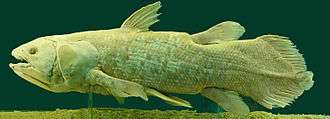 Coelacanth caught in 1974 |
Tetrapods
| Date | Event |
|---|---|
| 390 Ma |
Some fresh water lobe-finned fish (Sarcopterygii) develop legs and give rise to the Tetrapoda. The first tetrapods evolved in shallow and swampy freshwater habitats. Primitive tetrapods developed from a lobe-finned fish (an "osteolepid Sarcopterygian"), with a two-lobed brain in a flattened skull, a wide mouth and a short snout, whose upward-facing eyes show that it was a bottom-dweller, and which had already developed adaptations of fins with fleshy bases and bones. (The "living fossil" coelacanth is a related lobe-finned fish without these shallow-water adaptations.) Tetrapod fishes used their fins as paddles in shallow-water habitats choked with plants and detritus. The universal tetrapod characteristics of front limbs that bend backward at the elbow and hind limbs that bend forward at the knee can plausibly be traced to early tetrapods living in shallow water.[16] [16] Panderichthys is a 90–130 cm (35–50 in) long fish from the Late Devonian period (380 Mya). It has a large tetrapod-like head. Panderichthys exhibits features transitional between lobe-finned fishes and early tetrapods. Trackway impressions made by something that resembles Ichthyostega's limbs were formed 390 Ma in Polish marine tidal sediments. This suggests tetrapod evolution is older than the dated fossils of Panderichthys through to Ichthyostega. Lungfishes retain some characteristics of the early Tetrapoda. One example is the Queensland lungfish. |
| 375 Ma |
Tiktaalik is a genus of sarcopterygian (lobe-finned) fishes from the late Devonian with many tetrapod-like features. It shows a clear link between Panderichthys and Acanthostega. |
| 365 Ma |
Acanthostega is an extinct amphibian, among the first animals to have recognizable limbs. It is a candidate for being one of the first vertebrates to be capable of coming onto land. It lacked wrists, and was generally poorly adapted for life on land. The limbs could not support the animal's weight. Acanthostega had both lungs and gills, also indicating it was a link between lobe-finned fish and terrestrial vertebrates. Ichthyostega is an early tetrapod. Being one of the first animals with legs, arms, and finger bones, Ichthyostega is seen as a hybrid between a fish and an amphibian. Ichthyostega had legs but its limbs probably were not used for walking. They may have spent very brief periods out of water and would have used their legs to paw their way through the mud.[17] Amphibia were the first four-legged animals to develop lungs which may have evolved from Hynerpeton 360 Mya. Amphibians living today still retain many characteristics of the early tetrapods. |
| 300 Ma |
From amphibians came the first reptiles: Hylonomus is the earliest known reptile. It was 20 cm (8 in) long (including the tail) and probably would have looked rather similar to modern lizards. It had small sharp teeth and probably ate millipedes and early insects. It is a precursor of later Amniotes and mammal-like reptiles. Αlpha keratin first evolves here. It is used in the claws of modern lizards and birds, and hair in mammals.[18] Evolution of the amniotic egg gives rise to the Amniota, reptiles that can reproduce on land and lay eggs on dry land. They did not need to return to water for reproduction. This adaptation gave them the capability to colonize the uplands for the first time. Reptiles have advanced nervous systems, compared to amphibians, with twelve pairs of cranial nerves. |
Mammals
| Date | Event |
|---|---|
| 256 Ma |  Phthinosuchus, an early Therapsid The earliest mammal-like reptiles are the pelycosaurs. The pelycosaurs were the first animals to have temporal fenestrae. Pelycosaurs are not therapsids but soon they gave rise to them. The Therapsida were the direct ancestor of mammals. The therapsids have temporal fenestrae larger and more mammal-like than pelycosaurs, their teeth show more serial differentiation, and later forms had evolved a secondary palate. A secondary palate enables the animal to eat and breathe at the same time and is a sign of a more active, perhaps warm-blooded, way of life.[19] |
| 220 Ma |
One sub-group of therapsids, the cynodonts, evolved more mammal-like characteristics. The jaws of cynodonts resemble modern mammal jaws. This group of animals likely contains a species which is the direct ancestor of all modern mammals.[20] |
| 220 Ma |
From Eucynodontia (cynodonts) came the first mammals. Most early mammals were small shrew-like animals that fed on insects. Although there is no evidence in the fossil record, it is likely that these animals had a constant body temperature and milk glands for their young. The neocortex region of the brain first evolved in mammals and thus is unique to them. Monotremes are an egg-laying group of mammals represented amongst modern animals by the platypus and echidna. Recent genome sequencing of the platypus indicates that its sex genes are closer to those of birds than to those of the therian (live birthing) mammals. Comparing this to other mammals, it can be inferred that the first mammals to gain sexual differentiation through the existence or lack of SRY gene (found in the y-Chromosome) evolved after the monotreme lineage split off. |
| 160 Ma |
Juramaia sinensis[21] is the earliest known eutherian mammal fossil. |
| 100 Ma | Last common ancestor of mice and humans (base of the clade Euarchontoglires). |
Primates
| Date | Event |
|---|---|
| 85–66 Ma |
A group of small, nocturnal, arboreal, insect-eating mammals called Euarchonta begins a speciation that will lead to the orders of primates, treeshrews and flying lemurs. Primatomorpha is a subdivision of Euarchonta including primates and their ancestral stem-primates Plesiadapiformes. An early stem-primate, Plesiadapis, still had claws and eyes on the side of the head, making it faster on the ground than in the trees, but it began to spend long times on lower branches, feeding on fruits and leaves. The Plesiadapiformes very likely contain the ancestor species of all primates.[22] They first appeared in the fossil record around 66 million years ago, soon after the Cretaceous–Paleogene extinction event that eliminated about three-quarters of plant and animal species on Earth, including most dinosaurs.[23][24] One of the last Plesiadapiformes is Carpolestes simpsoni, having grasping digits but not forward-facing eyes. |
| 63 Ma | Primates diverge into suborders Strepsirrhini (wet-nosed primates) and Haplorrhini (dry-nosed primates). Strepsirrhini contain most prosimians; modern examples include lemurs and lorises. The haplorrhines include the two living groups: prosimian tarsiers, and simian monkeys, including apes. One of the earliest haplorrhines is Teilhardina asiatica, a mouse-sized, diurnal creature with small eyes. The Haplorrhini metabolism lost the ability to produce vitamin C, forcing all descendants to include vitamin C-containing fruit in their diet. |
| 30 Ma |
Haplorrhini splits into infraorders Platyrrhini and Catarrhini. Platyrrhines, New World monkeys, have prehensile tails and males are color blind. The individuals whose descendants would become Platyrrhini are conjectured to have migrated to South America either on a raft of vegetation or via a land bridge (the hypothesis now favored[25]). Catarrhines mostly stayed in Africa as the two continents drifted apart. Possible early ancestors of catarrhines include Aegyptopithecus and Saadanius. |
| 25 Ma |
Catarrhini splits into 2 superfamilies, Old World monkeys (Cercopithecoidea) and apes (Hominoidea). Our trichromatic color vision had its genetic origins in this period. Proconsul was an early genus of catarrhine primates. They had a mixture of Old World monkey and ape characteristics. Proconsul's monkey-like features include thin tooth enamel, a light build with a narrow chest and short forelimbs, and an arboreal quadrupedal lifestyle. Its ape-like features are its lack of a tail, ape-like elbows, and a slightly larger brain relative to body size. Proconsul africanus is a possible ancestor of both great and lesser apes, including humans. |
Hominidae
| Date | Event |
|---|---|
| 18 Ma | Hominidae (great ape ancestors) speciate from the ancestors of the gibbon (lesser apes) between c. 20 to 16 Ma.[26] |
| 16 Ma | Homininae ancestors speciate from the ancestors of the orangutan between c. 18 to 14 Ma.[27]
Pierolapithecus catalaunicus is thought to be a common ancestor of humans and the other great apes, or at least a species that brings us closer to a common ancestor than any previous fossil discovery. It had the special adaptations for tree climbing as do present-day humans and other great apes: a wide, flat rib cage, a stiff lower spine, flexible wrists, and shoulder blades that lie along its back. |
| 12 Ma | Danuvius guggenmosi is the first-discovered Late Miocene great ape with preserved long bones, and greatly elucidates the anatomical structure and locomotion of contemporary apes.[28] It had adaptations for both hanging in trees (suspensory behavior) and walking on two legs (bipedalism)—whereas, among present-day hominids, humans are better adapted for the latter and the others for the former. Danuvius thus had a method of locomotion unlike any previously known ape called "extended limb clambering", walking directly along tree branches as well as using arms for suspending itself. The last common ancestor between humans and other apes possibly had a similar method of locomotion. |
| 10 Ma | The clade currently represented by humans and the genus Pan (common chimpanzees and bonobos) splits from the ancestors of the gorillas between c. 10 to 8 Ma.[29] |
| 6 Ma | 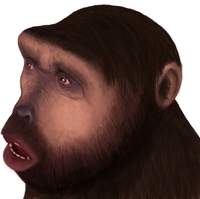 Sahelanthropus tchadensis Hominini: The latest common ancestor of humans and chimpanzees is estimated to have lived between roughly 10 to 5 million years ago. Both chimpanzees and humans have a larynx that repositions during the first two years of life to a spot between the pharynx and the lungs, indicating that the common ancestors have this feature, a precondition for vocalized speech in humans. Speciation may have begun shortly after 10 Ma, but late admixture between the lineages may have taken place until after 5 Ma. Candidates of Hominina or Homininae species which lived in this time period include Ouranopithecus (c. 8 Ma), Graecopithecus (c. 7 Ma), Sahelanthropus tchadensis (c. 7 Ma), Orrorin tugenensis (c. 6 Ma). Ardipithecus is, or may be, a very early hominin genus (tribe Hominini and subtribe Hominina). Two species are described in the literature: A. ramidus, which lived about 4.4 million years ago[30] during the early Pliocene, and A. kadabba, dated to approximately 5.6 million years ago[31] (late Miocene). A. ramidus had a small brain, measuring between 300 and 350 cm3. This is about the same size as the modern bonobo and female common chimpanzee brain; it is somewhat smaller than the brain of australopithecines like Lucy (400 to 550 cm3) and slightly over a fifth the size of the modern Homo sapiens brain.Ardipithecus was arboreal, meaning it lived largely in the forest where it competed with other forest animals for food, no doubt including the contemporary ancestor of the chimpanzees. Ardipithecus was probably bipedal as evidenced by its bowl shaped pelvis, the angle of its foramen magnum and its thinner wrist bones, though its feet were still adapted for grasping rather than walking for long distances. |
| 3.6 Ma |
A member of the Australopithecus afarensis left human-like footprints on volcanic ash in Laetoli, northern Tanzania, providing strong evidence of full-time bipedalism. Australopithecus afarensis lived between 3.9 and 2.9 million years ago, and is considered one of the earliest hominins—those species that developed and comprised the lineage of Homo and Homo's closest relatives after the split from the line of the chimpanzees. It is thought that A. afarensis was ancestral to both the genus Australopithecus and the genus Homo. Compared to the modern and extinct great apes, A. afarensis had reduced canines and molars, although they were still relatively larger than in modern humans. A. afarensis also has a relatively small brain size (380–430 cm³) and a prognathic (anterior-projecting) face. Australopithecines have been found in savannah environments; they probably developed their diet to include scavenged meat. Analyses of Australopithecus africanus lower vertebrae suggests that these bones changed in females to support bipedalism even during pregnancy. |
| 3.5–3.3 Ma | Kenyanthropus platyops, a possible ancestor of Homo, emerges from the Australopithecus. Stone tools are deliberately constructed.[32] |
| 3 Ma | The bipedal australopithecines (a genus of the subtribe Hominina) evolve in the savannas of Africa being hunted by Megantereon. Loss of body hair occurs from 3 to 2 Ma, in parallel with the development of full bipedalism.[33] |
Homo
| Date | Event |
|---|---|
| 2.5–2.0 Ma |
Early Homo appears in East Africa, speciating from australopithecine ancestors. Sophisticated stone tools mark the beginning of the Lower Paleolithic. Australopithecus garhi was using stone tools at about 2.5 Ma. Homo habilis is the oldest species given the designation Homo, by Leakey et al. (1964). H. habilis is intermediate between Australopithecus afarensis and H. erectus, and there have been suggestions to re-classify it within genus Australopithecus, as Australopithecus habilis. Stone tools found at the Shangchen site in China and dated to 2.12 million years ago are considered the earliest known evidence of hominins outside Africa, surpassing Dmanisi in Georgia by 300,000 years.[34] |
| 1.9–0.5 Ma | A reconstruction of Homo erectus Homo erectus derives from early Homo or late Australopithecus. Homo habilis, although significantly different of anatomy and physiology, is thought to be the ancestor of Homo ergaster, or African Homo erectus; but it is also known to have coexisted with H. erectus for almost half a million years (until about 1.5 Ma). From its earliest appearance at about 1.9 Ma, H. erectus is distributed in East Africa and Southwest Asia (Homo georgicus). H. erectus is the first known species to develop control of fire, by about 1.5 Ma. H. erectus later migrates throughout Eurasia, reaching Southeast Asia by 0.7 Ma. It is described in a number of subspecies.[35] Evolution of dark skin at about 1.2 Ma.[36] Homo antecessor may be a common ancestor of humans and Neanderthals.[37][38] At present estimate, humans have approximately 20,000–25,000 genes and share 99% of their DNA with the now extinct Neanderthal [39] and 95–99% of their DNA with their closest living evolutionary relative, the chimpanzees.[40][41] The human variant of the FOXP2 gene (linked to the control of speech) has been found to be identical in Neanderthals.[42] |
| 0.8–0.3 Ma | _new.jpg) Reconstruction of Homo heidelbergensis Divergence of Neanderthal and Denisovan lineages from a common ancestor.[43] Homo heidelbergensis (in Africa also known as Homo rhodesiensis) had long been thought to be a likely candidate for the last common ancestor of the Neanderthal and modern human lineages. However, genetic evidence from the Sima de los Huesos fossils published in 2016 seems to suggest that H. heidelbergensis in its entirety should be included in the Neanderthal lineage, as "pre-Neanderthal" or "early Neanderthal", while the divergence time between the Neanderthal and modern lineages has been pushed back to before the emergence of H. heidelbergensis, to about 600,000 to 800,000 years ago, the approximate age of Homo antecessor.[44][45] Solidified footprints dated to about 350 ka and associated with H. heidelbergensis were found in southern Italy in 2003.[46] |
Homo sapiens
| Date | Event |
|---|---|
| 300–130 ka | 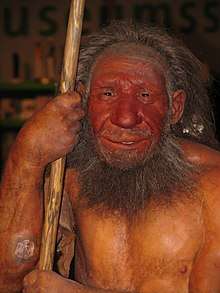 Reconstruction of H. neanderthalensis Fossils attributed to H. sapiens, along with stone tools, dated to approximately 300,000 years ago, found at Jebel Irhoud, Morocco[47] yield the earliest fossil evidence for anatomically modern Homo sapiens. Modern human presence in East Africa (Gademotta), at 276 kya.[48] A 177,000-year-old jawbone fossil discovered in Israel in 2017 is the oldest human remains found outside Africa.[49] However, in July 2019, anthropologists reported the discovery of 210,000 year old remains of a H. sapiens and 170,000 year old remains of a H. neanderthalensis in Apidima Cave, Peloponnese, Greece, more than 150,000 years older than previous H. sapiens finds in Europe.[50][51][52] Neanderthals emerge from the Homo heidelbergensis lineage at about the same time (300 ka). Patrilineal and matrilineal most recent common ancestors (MRCAs) of living humans roughly between 200 and 100 ka[53][54] with some estimates on the patrilineal MRCA somewhat higher, ranging up to 250 to 500 kya.[55] 160,000 years ago, Homo sapiens idaltu in the Awash River Valley (near present-day Herto village, Ethiopia) practiced excarnation.[56] |
| 130–80 ka | Marine Isotope Stage 5 (Eemian).
Modern human presence in Southern Africa and West Africa.[57] Appearance of mitochondrial haplogroup (mt-haplogroup) L2. |
| 80–50 ka | MIS 4, beginning of the Upper Paleolithic.
Early evidence for behavioral modernity.[58] Appearance of mt-haplogroups M and N. Southern Dispersal migration out of Africa, Proto-Australoid peopling of Oceania.[59] Archaic admixture from Neanderthals in Eurasia,[60][61] from Denisovans in Oceania with trace amounts in Eastern Eurasia,[62] and from an unspecified African lineage of archaic humans in Sub-Saharan Africa as well as an interbred species of Neanderthals and Denisovans in Asia and Oceania.[63][64][65][66] |
| 50–25 ka |
.jpg) Reconstruction of Oase 2 (c. 40 ka) Behavioral modernity develops, according to the "great leap forward" theory.[67] Extinction of Homo floresiensis.[68] M168 mutation (carried by all non-African males). Appearance of mt-haplogroups U and K. Peopling of Europe, peopling of the North Asian Mammoth steppe. Paleolithic art. Extinction of Neanderthals and other archaic human variants (with possible survival of hybrid populations in Asia and Africa.) Appearance of Y-Haplogroup R2; mt-haplogroups J and X. |
| after 25 ka | 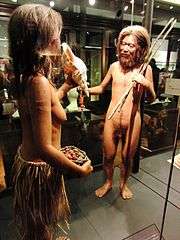 Minatogawa Man (Proto-Mongoloid, c. 20–14 ka) Last Glacial Maximum; Epipaleolithic / Mesolithic / Holocene. Peopling of the Americas. Appearance of: Y-Haplogroup R1a; mt-haplogroups V and T. Various recent divergence associated with environmental pressures, e.g. light skin in Europeans and East Asians (KITLG, ASIP), after 30 ka;[69] Inuit adaptation to high-fat diet and cold climate, 20 ka.[70] Extinction of late surviving archaic humans at the beginning of the Holocene (12 ka). Accelerated divergence due to selection pressures in populations participating in the Neolithic Revolution after 12 ka, e.g. East Asian types of ADH1B associated with rice domestication,[71] or lactase persistence.[72][73] |
See also
References
- Finarelli, J.A.; Clyde, W.C. (2004). "Reassessing hominoid phylogeny: Evaluating congruence in the morphological and temporal data". Paleobiology. 30 (4): 614.
- Patterson N, Richter DJ, Gnerre S, Lander ES, Reich D (2006). "Genetic evidence for complex speciation of humans and chimpanzees". Nature. 441 (7097): 1103–08. Bibcode:2006Natur.441.1103P. doi:10.1038/nature04789. PMID 16710306.
- depending on the classification of the Homo heidelbergensis lineage; 0.8 if Neanderthals are classed as H. sapiens neanderthalensis, or if H. sapiens is defined cladistically from the divergence from H. neanderthalensis, 0.3 based on the available fossil evidence.
- "'Experiments with sex have been very hard to conduct,' Goddard said. 'In an experiment, one needs to hold all else constant, apart from the aspect of interest. This means that no higher organisms can be used, since they have to have sex to reproduce and therefore provide no asexual control.'
Goddard and colleagues instead turned to a single-celled organism, yeast, to test the idea that sex allows populations to adapt to new conditions more rapidly than asexual populations." Sex Speeds Up Evolution, Study Finds (URL accessed on January 9, 2005) - Dawkins, R. (2005), The Ancestor's Tale: A Pilgrimage to the Dawn of Evolution, Houghton Mifflin Harcourt, ISBN 978-0-618-61916-0
- "Proterospongia is a rare freshwater protist, a colonial member of the Choanoflagellata." "Proterospongia itself is not the ancestor of sponges. However, it serves as a useful model for what the ancestor of sponges and other metazoans may have been like." http://www.ucmp.berkeley.edu/protista/proterospongia.html Berkeley University
- Maloof, Adam C.; Rose, Catherine V.; Beach, Robert; Samuels, Bradley M.; Calmet, Claire C.; Erwin, Douglas H.; Poirier, Gerald R.; Yao, Nan; Simons, Frederik J. (17 August 2010). "Possible animal-body fossils in pre-Marinoan limestones from South Australia". Nature Geoscience. 3 (9): 653–59. Bibcode:2010NatGe...3..653M. doi:10.1038/ngeo934.
- Barnes, Robert D. (1982). Invertebrate Zoology. Philadelphia: Holt-Saunders International. pp. 1018–26. ISBN 978-0-03-056747-6.
- "Obviously vertebrates must have had ancestors living in the Cambrian, but they were assumed to be invertebrate forerunners of the true vertebrates — protochordates. Pikaia has been heavily promoted as the oldest fossil protochordate." Richard Dawkins 2004 The Ancestor's Tale p. 289, ISBN 0-618-00583-8
- Shu, D.G.; Luo, H.L.; Conway Morris, S.; Zhang, X. L.; Hu, S.X.; Chen, L.; Han, J.; Zhu, M.; Li, Y.; Chen, L.Z. (1999). "Lower Cambrian vertebrates from south China". Nature. 402 (6757): 42–46. Bibcode:1999Natur.402...42S. doi:10.1038/46965.
- Chen, J.Y.; Huang, D.Y.; Li, C.W. (1999). "An early Cambrian craniate-like chordate". Nature. 402 (6761): 518–22. Bibcode:1999Natur.402..518C. doi:10.1038/990080.
- Shu, D.-G.; Morris, S. Conway; Han, J.; Zhang, Z.-F.; Yasui, K.; Janvier, P.; Chen, L.; Zhang, X.-L.; Liu, J.-N.; Li, Y.; Liu, H.-Q. (January 2003). "Head and backbone of the Early Cambrian vertebrate Haikouichthys". Nature. 421 (6922): 526–529. Bibcode:2003Natur.421..526S. doi:10.1038/nature01264. PMID 12556891.
- These first vertebrates lacked jaws, like the living hagfish and lampreys. Jawed vertebrates appeared 100 million years later, in the Silurian. http://www.ucmp.berkeley.edu/vertebrates/vertintro.html Berkeley University
- "Bones of first gill arch became upper and lower jaws." (Image)
- A fossil coelacanth jaw found in a stratum datable 410 mya that was collected near Buchan in Victoria, Australia's East Gippsland, currently holds the record for oldest coelacanth; it was given the name Eoactinistia foreyi when it was published in September 2006.
- "Lungfish are believed to be the closest living relatives of the tetrapods, and share a number of important characteristics with them. Among these characters are tooth enamel, separation of pulmonary blood flow from body blood flow, arrangement of the skull bones, and the presence of four similarly sized limbs with the same position and structure as the four tetrapod legs." http://www.ucmp.berkeley.edu/vertebrates/sarco/dipnoi.html Berkeley University
- "the ancestor that amphibians share with reptiles and ourselves?" "These possibly transitional fossils have been much studied, among them Acanthostega, which seems to have been wholly aquatic, and Ichthyostega" Richard Dawkins 2004 The Ancestor's Tale p. 250, ISBN 0-618-00583-8
- Eckhart, L.; Valle, L. D.; Jaeger, K.; Ballaun, C.; Szabo, S.; Nardi, A.; Buchberger, M.; Hermann, M.; Alibardi, L.; Tschachler, E. (10 November 2008). "Identification of reptilian genes encoding hair keratin-like proteins suggests a new scenario for the evolutionary origin of hair". Proceedings of the National Academy of Sciences. 105 (47): 18419–18423. doi:10.1073/pnas.0805154105. PMC 2587626. PMID 19001262.
- "In many respects, the pelycosaurs are intermediate between the reptiles and mammals" http://www.ucmp.berkeley.edu/synapsids/pelycosaurs.html Berkeley University
- "Thrinaxodon, like any fossil, should be thought of as a cousin of our ancestor, not the ancestor itself. It was a member of a group of mammal-like reptiles called the cynodonts. The cynodonts were so mammal-like, it is tempting to call them mammals. But who cares what we call them? They are almost perfect intermediates." Richard Dawkins 2004 The Ancestor's Tale p. 211, ISBN 0-618-00583-8
- Luo, ZX; Yuan, CX; Meng, QJ; Ji, Q (Aug 2011). "A Jurassic eutherian mammal and divergence of marsupials and placentals". Nature. 476 (7361): 442–45. Bibcode:2011Natur.476..442L. doi:10.1038/nature10291. PMID 21866158.
- "Fossils that might help us reconstruct what Concestor 8 was like include the large group called plesiadapi-forms. They lived about the right time, and they have many of the qualities you would expect of the grand ancestor of all the primates" Richard Dawkins 2004 The Ancestor's Tale p. 136, ISBN 0-618-00583-8
- Renne, Paul R.; Deino, Alan L.; Hilgen, Frederik J.; Kuiper, Klaudia F.; Mark, Darren F.; Mitchell, William S.; Morgan, Leah E.; Mundil, Roland; Smit, Jan (7 February 2013). "Time Scales of Critical Events Around the Cretaceous-Paleogene Boundary". Science. 339 (6120): 684–87. Bibcode:2013Sci...339..684R. doi:10.1126/science.1230492. PMID 23393261.
- "Paleontologists discover most primitive primate skeleton", Phys.org (January 23, 2007).
- Alan de Queiroz, The Monkey's Voyage, Basic Books, 2014.
- "A new primate species at the root of the tree of extant hominoids". phys.org. Retrieved 2020-05-29.
- Raauma, Ryan; Sternera, K (2005). "Catarrhine primate divergence dates estimated from complete mitochondrial genomes" (PDF). Journal of Human Evolution. 48 (3): 237–57. doi:10.1016/j.jhevol.2004.11.007. PMID 15737392.
- Böhme, Madelaine; Spassov, Nikolai; Fuss, Jochen; Tröscher, Adrian; Deane, Andrew S.; Prieto, Jérôme; Kirscher, Uwe; Lechner, Thomas; Begun, David R. (November 2019). "A new Miocene ape and locomotion in the ancestor of great apes and humans". Nature. 575 (7783): 489–493. doi:10.1038/s41586-019-1731-0. ISSN 1476-4687.
- Popadin, Konstantin; Gunbin, Konstantin; Peshkin, Leonid; Annis, Sofia; Fleischmann, Zoe; Kraytsberg, Genya; Markuzon, Natalya; Ackermann, Rebecca R.; Khrapko, Konstantin (2017-10-19). "Mitochondrial pseudogenes suggest repeated inter-species hybridization in hominid evolution". bioRxiv: 134502. doi:10.1101/134502.
- Perlman, David (July 12, 2001). "Fossils From Ethiopia May Be Earliest Human Ancestor". National Geographic News.
Another co-author is Tim D. White, a paleoanthropologist at UC-Berkeley who in 1994 discovered a pre-human fossil, named Ardipithecus ramidus, that was then the oldest known, at 4.4 million years.
- White, Tim D.; Asfaw, Berhane; Beyene, Yonas; Haile-Selassie, Yohannes; Lovejoy, C. Owen; Suwa, Gen; WoldeGabriel, Giday (2009). "Ardipithecus ramidus and the Paleobiology of Early Hominids". Science. 326 (5949): 75–86. Bibcode:2009Sci...326...75W. doi:10.1126/science.1175802. PMID 19810190.
- Harmand, Sonia; Lewis, Jason E.; Feibel, Craig S.; Lepre, Christopher J.; Prat, Sandrine; Lenoble, Arnaud; Boës, Xavier; Quinn, Rhonda L.; Brenet, Michel; Arroyo, Adrian; Taylor, Nicholas; Clément, Sophie; Daver, Guillaume; Brugal, Jean-Philip; Leakey, Louise; Mortlock, Richard A.; Wright, James D.; Lokorodi, Sammy; Kirwa, Christopher; Kent, Dennis V.; Roche, Hélène (2015). "3.3-million-year-old stone tools from Lomekwi 3, West Turkana, Kenya". Nature. 521 (7552): 310–15. Bibcode:2015Natur.521..310H. doi:10.1038/nature14464. PMID 25993961.
- Ruxton, Graeme D.; Wilkinson, David M. (2011-12-27). "Avoidance of overheating and selection for both hair loss and bipedality in hominins". Proceedings of the National Academy of Sciences. 108 (52): 20965–20969. doi:10.1073/pnas.1113915108. ISSN 0027-8424. PMID 22160694.
- Zhu, Zhaoyu; Dennell, Robin; Huang, Weiwen; Wu, Yi; Qiu, Shifan; Yang, Shixia; Rao, Zhiguo; Hou, Yamei; Xie, Jiubing; Han, Jiangwei; Ouyang, Tingping (2018). "Hominin occupation of the Chinese Loess Plateau since about 2.1 million years ago". Nature. 559 (7715): 608–12. Bibcode:2018Natur.559..608Z. doi:10.1038/s41586-018-0299-4. PMID 29995848.
- NOVA: Becoming Human Part 2 http://video.pbs.org/video/1319997127/
- Jablonski, Nina G. (October 2004). "The Evolution of Human Skin and Skin Color". Annual Review of Anthropology. 33 (1): 585–623. doi:10.1146/annurev.anthro.33.070203.143955.
- Bermudez de Castro, J. M. (30 May 1997). "A Hominid from the Lower Pleistocene of Atapuerca, Spain: Possible Ancestor to Neandertals and Modern Humans". Science. 276 (5317): 1392–1395. doi:10.1126/science.276.5317.1392. PMID 9162001.
- Green, Richard E.; Krause, Johannes; Ptak, Susan E.; Briggs, Adrian W.; Ronan, Michael T.; Simons, Jan F.; Du, Lei; Egholm, Michael; Rothberg, Jonathan M.; Paunovic, Maja; Pääbo, Svante (November 2006). "Analysis of one million base pairs of Neanderthal DNA". Nature. 444 (7117): 330–336. Bibcode:2006Natur.444..330G. doi:10.1038/nature05336. PMID 17108958.
- "Rubin also said analysis so far suggests human and Neanderthal DNA are some 99.5 percent to nearly 99.9 percent identical." Neanderthal bone gives DNA clues (URL accessed on November 16, 2006)
- "The conclusion is the old saw that we share 98.5% of our DNA sequence with chimpanzee is probably in error. For this sample, a better estimate would be that 95% of the base pairs are exactly shared between chimpanzee and human DNA." Britten, R.J. (2002). "Divergence between samples of chimpanzee and human DNA sequences is 5%, counting indels". PNAS. 99 (21): 13633–35. Bibcode:2002PNAS...9913633B. doi:10.1073/pnas.172510699. PMC 129726. PMID 12368483.
- "...of the three billion letters that make up the human genome, only 15 million—less than 1 percent—have changed in the six million years or so since the human and chimp lineages diverged." Pollard, K.S. (2009). "What makes us human?". Scientific American. 300–5 (5): 44–49. Bibcode:2009SciAm.300e..44P. doi:10.1038/scientificamerican0509-44. PMID 19438048.
- Krause J, Lalueza-Fox C, Orlando L, Enard W, Green RE, Burbano HA, Hublin JJ, Hänni C, Fortea J, de la Rasilla M, Bertranpetit J, Rosas A, Pääbo S (November 2007). "The derived FOXP2 variant of modern humans was shared with Neandertals". Curr. Biol. 17 (21): 1908–12. doi:10.1016/j.cub.2007.10.008. hdl:11858/00-001M-0000-000F-FED3-1. PMID 17949978. Lay summary – New York Times (2007-10-19).
- Stein, Richard A. (October 2015). "Copy Number Analysis Starts to Add Up". Genetic Engineering & Biotechnology News. 35 (17): 20, 22–23. doi:10.1089/gen.35.17.09.
- Meyer, Matthias; Arsuaga, Juan-Luis; De Filippo, Cesare; Nagel, Sarah; Aximu-Petri, Ayinuer; Nickel, Birgit; Martínez, Ignacio; Gracia, Ana; De Castro, José María Bermúdez; Carbonell, Eudald; Viola, Bence; Kelso, Janet; Prüfer, Kay; Pääbo, Svante (March 2016). "Nuclear DNA sequences from the Middle Pleistocene Sima de los Huesos hominins". Nature. 531 (7595): 504–07. Bibcode:2016Natur.531..504M. doi:10.1038/nature17405. PMID 26976447.
- Callaway, Ewen (2016). "Oldest ancient-human DNA details dawn of Neanderthals". Nature. 531 (7594): 296–86. Bibcode:2016Natur.531..296C. doi:10.1038/531286a. PMID 26983523.
- Mietto, Paolo; Avanzini, Marco; Rolandi, Giuseppe (2003). "Palaeontology: Human footprints in Pleistocene volcanic ash". Nature. 422 (6928): 133. Bibcode:2003Natur.422..133M. doi:10.1038/422133a. PMID 12634773.
- Callaway, Ewen (7 June 2017). "Oldest Homo sapiens fossil claim rewrites our species' history". Nature. doi:10.1038/nature.2017.22114.
- Tryon, Christopher A.; Faith, Tyler (2013). "Variability in the Middle Stone Age of Eastern Africa" (PDF). Current Anthropology. 54 (8): 234–54. doi:10.1086/673752.
- Mehta, Ankita (26 January 2018). "A 177,000-year-old jawbone fossil discovered in Israel is oldest human remains found outside Africa". International Business Times. Retrieved 28 January 2018.
- Zimmer, Carl (10 July 2019). "A Skull Bone Discovered in Greece May Alter the Story of Human Prehistory - The bone, found in a cave, is the oldest modern human fossil ever discovered in Europe. It hints that humans began leaving Africa far earlier than once thought". The New York Times. Retrieved 11 July 2019.
- Staff (10 July 2019). "'Oldest remains' outside Africa reset human migration clock". Phys.org. Retrieved 10 July 2019.
- Harvati, Katerina; et al. (10 July 2019). "Apidima Cave fossils provide earliest evidence of Homo sapiens in Eurasia". Nature. 571 (7766): 500–504. doi:10.1038/s41586-019-1376-z. PMID 31292546.
- Heinz, Tanja; Pala, Maria; Gómez-Carballa, Alberto; Richards, Martin B.; Salas, Antonio (March 2017). "Updating the African human mitochondrial DNA tree: Relevance to forensic and population genetics". Forensic Science International: Genetics. 27: 156–159. doi:10.1016/j.fsigen.2016.12.016. PMID 28086175.
- Poznik, G. D.; Henn, B. M.; Yee, M.-C.; Sliwerska, E.; Euskirchen, G. M.; Lin, A. A.; Snyder, M.; Quintana-Murci, L.; Kidd, J. M.; Underhill, P. A.; Bustamante, C. D. (1 August 2013). "Sequencing Y Chromosomes Resolves Discrepancy in Time to Common Ancestor of Males Versus Females". Science. 341 (6145): 562–565. Bibcode:2013Sci...341..562P. doi:10.1126/science.1237619. PMC 4032117. PMID 23908239.
- Karmin, Monika; Saag, Lauri; Vicente, Mário; Sayres, Melissa A. Wilson; Järve, Mari; Talas, Ulvi Gerst; Rootsi, Siiri; Ilumäe, Anne-Mai; Mägi, Reedik; Mitt, Mario; Pagani, Luca; Puurand, Tarmo; Faltyskova, Zuzana; Clemente, Florian; Cardona, Alexia; Metspalu, Ene; Sahakyan, Hovhannes; Yunusbayev, Bayazit; Hudjashov, Georgi; DeGiorgio, Michael; Loogväli, Eva-Liis; Eichstaedt, Christina; Eelmets, Mikk; Chaubey, Gyaneshwer; Tambets, Kristiina; Litvinov, Sergei; Mormina, Maru; Xue, Yali; Ayub, Qasim; et al. (April 2015). "A recent bottleneck of Y chromosome diversity coincides with a global change in culture". Genome Research. 25 (4): 459–466. doi:10.1101/gr.186684.114. PMC 4381518. PMID 25770088.
- Clark, J. Desmond; Beyene, Yonas; WoldeGabriel, Giday; Hart, William K.; Renne, Paul R.; Gilbert, Henry; Defleur, Alban; Suwa, Gen; Katoh, Shigehiro; Ludwig, Kenneth R.; Boisserie, Jean-Renaud; Asfaw, Berhane; White, Tim D. (June 2003). "Stratigraphic, chronological and behavioural contexts of Pleistocene Homo sapiens from Middle Awash, Ethiopia". Nature. 423 (6941): 747–752. Bibcode:2003Natur.423..747C. doi:10.1038/nature01670. PMID 12802333.
- Scerri, Eleanor (2017). "Oxford Research Encyclopedia of African History". doi:10.1093/acrefore/9780190277734.013.137. ISBN 9780190277734. Cite journal requires
|journal=(help);|chapter=ignored (help) - Henshilwood, C.S. and B. Dubreuil 2009. Reading the artifacts: gleaning language skills from the Middle Stone Age in southern Africa. In R. Botha and C. Knight (eds), The Cradle of Language. Oxford: Oxford University Press, pp. 41-61.
- Bowler JM, Johnston H, Olley JM, Prescott JR, Roberts RG, Shawcross W, Spooner NA (2003). "New ages for human occupation and climatic change at Lake Mungo, Australia". Nature. 421 (6925): 837–40. Bibcode:2003Natur.421..837B. doi:10.1038/nature01383. PMID 12594511.
- Richard E. Green; Krause, J.; Briggs, A.W.; Maricic, T.; Stenzel, U.; Kircher, M.; Patterson, N.; Li, H.; et al. (2010). "A Draft Sequence of the Neandertal Genome". Science. 328 (5979): 710–22. Bibcode:2010Sci...328..710G. doi:10.1126/science.1188021. PMC 5100745. PMID 20448178.
- Rincon, Paul (2010-05-06). "Neanderthal genes 'survive in us'". BBC News. BBC. Retrieved 2010-05-07.
- Sankararaman, Sriram; Mallick, Swapan; Patterson, Nick; Reich, David (2016). "The Combined Landscape of Denisovan and Neanderthal Ancestry in Present-Day Humans". Current Biology. 26 (9): 1241–1247. doi:10.1016/j.cub.2016.03.037. PMC 4864120. PMID 27032491.
- Callaway, Ewen (26 July 2012). "Hunter-gatherer genomes a trove of genetic diversity". Nature. doi:10.1038/nature.2012.11076.
- Lachance, Joseph; Vernot, Benjamin; Elbers, Clara C.; Ferwerda, Bart; Froment, Alain; Bodo, Jean-Marie; Lema, Godfrey; Fu, Wenqing; Nyambo, Thomas B.; Rebbeck, Timothy R.; Zhang, Kun; Akey, Joshua M.; Tishkoff, Sarah A. (August 2012). "Evolutionary History and Adaptation from High-Coverage Whole-Genome Sequences of Diverse African Hunter-Gatherers". Cell. 150 (3): 457–469. doi:10.1016/j.cell.2012.07.009. PMC 3426505. PMID 22840920.
- Xu, Duo; Pavlidis, Pavlos; Taskent, Recep Ozgur; Alachiotis, Nikolaos; Flanagan, Colin; DeGiorgio, Michael; Blekhman, Ran; Ruhl, Stefan; Gokcumen, Omer (October 2017). "Archaic Hominin Introgression in Africa Contributes to Functional Salivary MUC7 Genetic Variation". Molecular Biology and Evolution. 34 (10): 2704–2715. doi:10.1093/molbev/msx206. PMC 5850612. PMID 28957509.
- Mondal, Mayukh; Bertranpetit, Jaume; Lao, Oscar (16 January 2019). "Approximate Bayesian computation with deep learning supports a third archaic introgression in Asia and Oceania". Nature Communications. 10 (1): 246. Bibcode:2019NatCo..10..246M. doi:10.1038/s41467-018-08089-7. PMC 6335398. PMID 30651539.
- Klein, Richard (1995). "Anatomy, behavior, and modern human origins". Journal of World Prehistory. 9 (2): 167–98. doi:10.1007/bf02221838.
- Sutikna, Thomas; Tocheri, Matthew W.; Morwood, Michael J.; Saptomo, E. Wahyu; Jatmiko; Awe, Rokus Due; Wasisto, Sri; Westaway, Kira E.; Aubert, Maxime; Li, Bo; Zhao, Jian-xin; Storey, Michael; Alloway, Brent V.; Morley, Mike W.; Meijer, Hanneke J.M.; van den Bergh, Gerrit D.; Grün, Rainer; Dosseto, Anthony; Brumm, Adam; Jungers, William L.; Roberts, Richard G. (30 March 2016). "Revised stratigraphy and chronology for Homo floresiensis at Liang Bua in Indonesia". Nature. 532 (7599): 366–69. Bibcode:2016Natur.532..366S. doi:10.1038/nature17179. PMID 27027286.
- Belezal, Sandra; Santos, A.M.; McEvoy, B.; Alves, I.; Martinho, C.; Cameron, E.; Shriver, M.D.; Parra, E.J.; Rocha, J. (2012). "The timing of pigmentation lightening in Europeans". Molecular Biology and Evolution. 30 (1): 24–35. doi:10.1093/molbev/mss207. PMC 3525146. PMID 22923467.
- Fumagalli, M.; Moltke, I.; Grarup, N.; Racimo, F.; Bjerregaard, P.; Jorgensen, M. E.; Korneliussen, T. S.; Gerbault, P.; Skotte, L.; Linneberg, A.; Christensen, C.; Brandslund, I.; Jorgensen, T.; Huerta-Sanchez, E.; Schmidt, E. B.; Pedersen, O.; Hansen, T.; Albrechtsen, A.; Nielsen, R. (17 September 2015). "Greenlandic Inuit show genetic signatures of diet and climate adaptation". Science. 349 (6254): 1343–1347. Bibcode:2015Sci...349.1343F. doi:10.1126/science.aab2319. hdl:10044/1/43212. PMID 26383953.
- Peng, Yi; Shi, Hong; Qi, Xue-bin; Xiao, Chun-jie; Zhong, Hua; Ma, Run-lin Z; Su, Bing (2010). "The ADH1B Arg47His polymorphism in East Asian populations and expansion of rice domestication in history". BMC Evolutionary Biology. 10 (1): 15. doi:10.1186/1471-2148-10-15. PMC 2823730. PMID 20089146.
- Ségurel, Laure; Bon, Céline (31 August 2017). "On the Evolution of Lactase Persistence in Humans". Annual Review of Genomics and Human Genetics. 18 (1): 297–319. doi:10.1146/annurev-genom-091416-035340. PMID 28426286.
- Ingram, Catherine J. E.; Mulcare, Charlotte A.; Itan, Yuval; Thomas, Mark G.; Swallow, Dallas M. (26 November 2008). "Lactose digestion and the evolutionary genetics of lactase persistence". Human Genetics. 124 (6): 579–591. doi:10.1007/s00439-008-0593-6. PMID 19034520.
External links
- Palaeos
- Hominid Timeline
- Berkeley Evolution
- History of Animal Evolution
- Tree of Life Web Project – explore complete phylogenetic tree interactively
- Human Timeline (Interactive) – Smithsonian, National Museum of Natural History (August 2016).

